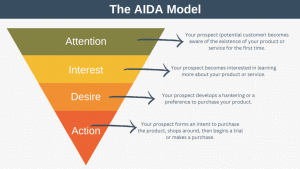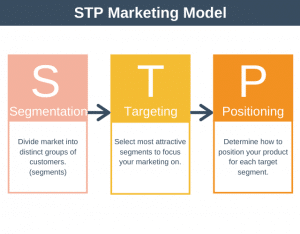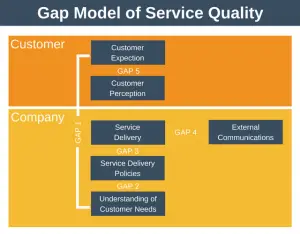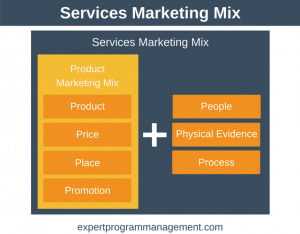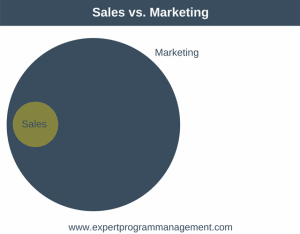The DRIP model an acronym standing for differentiate, reassure, inform, and persuade. It is also a marketing communications model.
The model was first described by Chris Fill in the third edition (2002) of his book Marketing Communications: Brand, Experiences, and Participation.
Why Use The DRIP Model
There are several reasons you might choose to use the DRIP model for your marketing communications, including that:
- It gives you a mechanism to communicate and convert prospects over the long term.
- It keeps your organization at the top of your prospect’s mind.
- It lets you put your best foot forward by enabling you to talk about what’s great about your products and services.
- Ultimately, it can lead to increased sales.
What is Marketing Communications
Before we look at the DRIP model, let’s begin by defining what we mean by marketing communications.
Marketing communications is concerned with the multitude of ways in which your organization’s prospects and customers engage with your organization.
At a macro level, your audience can engage with you in four ways.
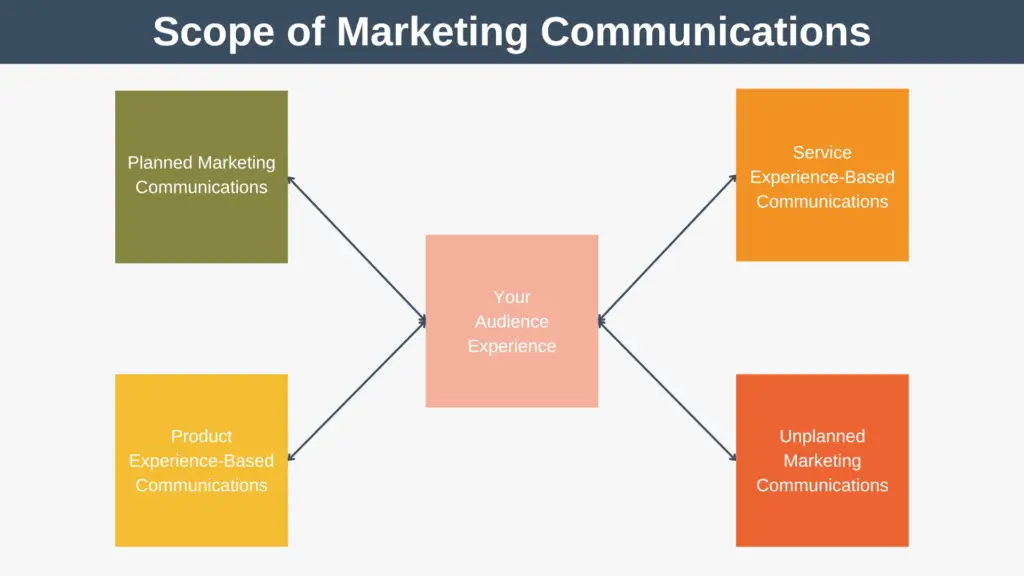
- Planned marketing communications: these are considered communications that you have timed to target specific audiences, for example, when you pay for radio advertising.
- Service experience-based communications: these communications happen when your customers use your services, for example, when your customer decides how good the service in your hotel is.
- Product experience-based communications: these communications happen when customers use your products, for example, when a customer decides how delicious your chocolate bar is.
- Unplanned marketing communications: these communications are unintentional and uncontrollable and happen for several reasons. For example, when one customer tells another about your product, when an influencer creates a review of your product, or when a customer wants to buy your product but you are out of stock.
As you can see, the field of marketing communications is very broad.
The DRIP Model
The DRIP model is concerned only with planned communications.
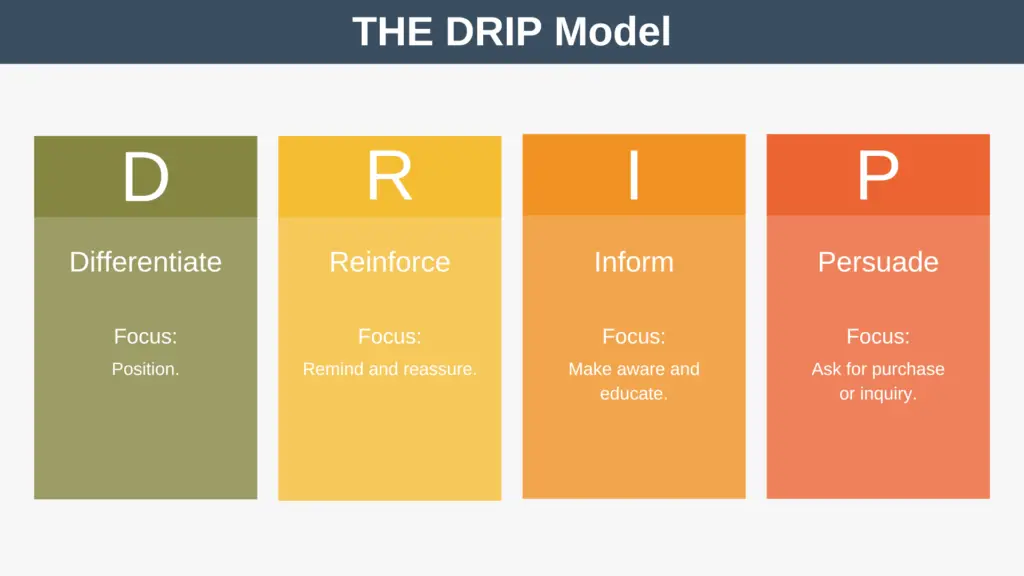
The DRIP model is about sending repeated communications to your prospects and customers. Your aim is to communicate what you do well and to do so regularly enough that you stay top-of-mind. Ultimately, you want your drip campaign to lead to increased sales inquiries or sales.
Let’s look at the aims of each part of the DRIP communication model.
1. Differentiate
Differentiate aims to position your product or service to stand out against your competitors.
This is all about explaining why a prospect should choose your company over your competitors. This is particularly important when your products are similar to your competitors.
Example
For this example and all the examples in this section explaining the DRIP model, imagine that you run an online advertising agency and want to use the DRIP model to increase your sales.
The services your advertising agency offers are very similar to your competitors, so you decide to send an email to your prospects to highlight how you’re better than your competitors.
Your points of differentiation include the excellent results you’ve achieved for previous clients and the unique process you use to engage with your clients.
2. Reinforce
The purpose here is to reinforce and strengthen a previous message or to reassure prospects about using your products or services.
Example
As an advertising agency owner, you know your prospects don’t read every detail of every email you send. Because of this, you decide to send periodic emails reminding them of your key differentiators.
You also decide to send periodic emails to reassure your prospects that it is safe to do business with you. You do this by reminding them of your money-back guarantee and no-profit no-fee approach.
3. Inform
The focus of Inform is to make prospects aware and educate them. This differs from the differentiation step as you’re not trying to highlight why you’re different but simply trying to share information.
This could include telling your prospects or customers about new features or showing how an existing customer benefits from your product or service.
Example
To inform your prospects, you decide to send them an email informing them of two things:
- A new service you offer.
- The results of your recent “bring your dog to work day,” and you include photos of dogs in your office. You do this to engage with your prospects and leave them thinking that not only is your office a nice place to work but that your team looks lovely to work with.
4. Persuade
The focus here is to persuade prospects or customers to either buy from you or move to the next stage of the sales process, such as by making an inquiry.
Example
You could ask prospects to schedule a one-hour call with one of your team so you can see if you can help them.
Your aim here is to move them through the sales process but not try to get them over the line until you know you can help them and that they are excited for you to work with them. You don’t want to be too pushy.
How to Use the DRIP Model
Now that you understand the basics of the DRIP marketing communications model, here are some tips to help you get the most out of the model.
- Do not try to do everything in one communication. Your aim should be to communicate little and often to stay top-of-mind without overwhelming your prospects. Think of it as a drip drip drip approach (the clue is in the name).
- You don’t have to fully cover a single DRIP element in any correspondence. For example, it is not unusual to take multiple communications to explain how you are differentiated from your competitors.
- Aim for balance in terms of how often you send your communications and how often you ask for a sale. You want to educate and inform your audience without turning them off or being too pushy.
DRIP Model Example
For this example, imagine that you sell luxury, fair-trade, organic chocolate direct to consumers from your website. You want to build a DRIP marketing campaign to build your relationship with your prospects and stay top of mind.
You might structure a simple DRIP campaign over four emails as follows:
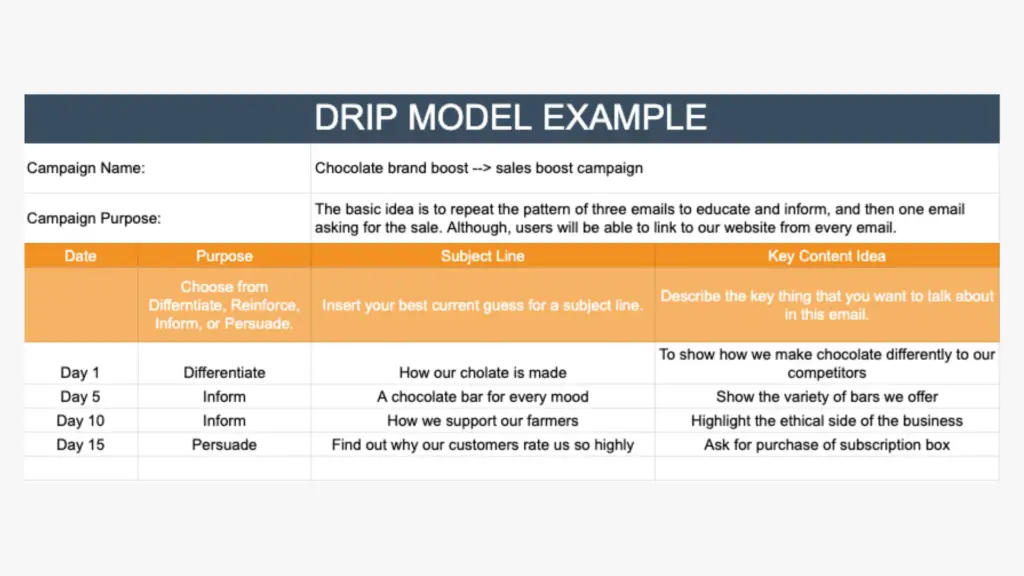
The basic idea in this example is to show your prospect what makes you different and educate them about your brand before asking for a sale:
- Your first email on day one talks about how you’re different from your competitors.
- Your second email informs them of all the different flavors of chocolate bars you offer.
- Your third email highlights the ethical aspect of your brand.
- Finally, your last email asks for a sale.
If you like, you could repeat this process of three informative emails followed by an email asking for a sale ad infinitum.
DRIP Model Template
If you’d like to plan your communications using the DRIP communications model, you can use our DRIP Model Template, which you can download here.

The template is an Excel file you can adapt in any way you like to suit the specifics of your communication campaigns.
DRIP Model vs. AIDA Model
A model often used as an alternative to the DRIP model is the AIDA model, which is an acronym for Attention, Interest, Desire, and Action.
To Sum Up
The Drip model of communication is a model that you can use to help manage your planned marketing communications with both prospects and existing customers. It helps you produce balanced communications that are sometimes informative and at other times ask for a sale.

